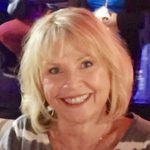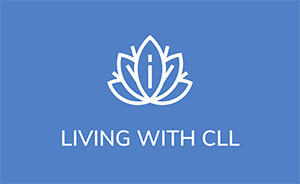
By Patti Jones – Patient
Throughout my life I have always been a very healthy woman, very seldom going to a doctor for even a routine checkup. My mom, dad and grandparents all lived into their eighties and nineties. I guess I could say I came from a very good gene pool! There was never any history of leukemia in our family.
In late March of 2009, at 59 years old, I went to see my GP, feeling that for the first time in my life I had a sinus infection. He sent me for a blood test and it came back that my WBC was 42,600. I was sent back for another blood test to confirm the count and this time it was 42,800. I asked him why he thought it was so high and he told me right then that he thought I had Chronic Lymphocytic Leukemia. He explained what it was, a cancer of the blood, and for some reason I never freaked out over the word “Cancer”. He then referred me to a local oncologist (I was on an HMO network at that time). On April 1, 2009 he confirmed that I did indeed have CLL. Over the next few months while I was on watch and wait, I had a FISH Analysis and Bone Marrow Aspiration. At that time it was determined that I had a very high-risk, aggressive form of CLL. The FISH test showed high expression of ZAP 70, unmutated IgVH, and high expression of CD38. Trisomy 12 and CD 5, CD 19 and CD 20 were all positive. They also found extra material on chromosome 2.
My watch and wait time lasted for only six months, when my WBC climbed to just over 100,000. At that time, in October of 2009, I was given my first treatment of four months of FCR (fludarabine, cyclophosphamide and rituximab). I feel that I was very fortunate as my remission from this treatment lasted exactly three years.
At close to three years, my WBC count had started to rise again. With a WBC over 180,000, my local oncologist sent me home and told me to come back in two weeks. At that point, I decided to seek out a second opinion from a hematologist at the University of California, Los Angeles (UCLA). This was probably one of the best decisions that I ever made. He told me that I needed to be in treatment and to not wait any longer. Within two days, I started my second, four month chemo treatment of BR (bendamustine and rituximab). I realized after seeing the hematologist at UCLA that I needed to seek out a CLL specialist. Again, I felt very fortunate that with this treatment of BR, my remission lasted almost exactly two years.
I decided to see Dr. Januario Castro, a CLL specialist at UCSD in San Diego, From April to September, I had a rapid progression of my CLL, with large lumpy nodes in my neck, chest and groin. In Sept of 2014, I was put on a clinical trial with infusions of HDMP (High dose Methylprednisolone) and an infusion of obinutuzumab (Gazyva). My treatments were completed in February, 2015, but this time I achieved only a partial remission. New tests showed that I had disease progression with lymphphadenopathy and lymphcytosis. After further testing, it was also determined that now I also had deletion 11q, deletion 13q, deletion 17p and deletion p53. It was also determined that I had 10% small T- Lymphocytes. Starting of Prolymphocytic Leukemia? This definitely was not good news!! At this time my doctor at UCSD told me that I would probably have no choice but to undergo a stem cell transplant, because I was pretty much out of other options. I was put on the donor registry and within one month the registry had found two perfect 10/10 matches, both with my same blood type. One was a 19 year old male and the other one a 30 year old male, both residing in Germany. So, needless to say I was very fortunate, because sometimes people who need a transplant wait months or years to find a perfect match and the registry had found me two.
I had made the decision that, if indeed I needed a stem cell transplant, I wanted to transfer my care to City of Hope (COH), where there have a designated transplant floor at Helford Hospital. I was fortunate enough to get introduced to the Provost of COH and Chief Scientific Officer, Dr. Steven Rosen, who then became my doctor in January, 2016. We discussed the stem cell transplant, but together we decided to participate in a clinical trial of idelalisib and rituximab. I was doing very well on the clinical trial, but after being on the trial for eight months, my lymph nodes were enlarging once again. I had another bone marrow aspiration, which revealed that my CLL had now progressed, to the worst thing that could have happened, Richter’s Transformation. Dr. Rosen called me on Saturday October 8, 2016 and told me that they would have a bed for me at Helford Hospital on Wednesday to start extensive chemo therapy.
Over the next couple of days, I found a clinical trial that would take a Richter’s patient, so I reached out to Dr. Nitin Jain, a doctor at MD Anderson Cancer Center in Houston, Texas. I opted for one more clinical trial before the stem cell transplant because I didn’t want to go through yet another harsh chemo treatment, just to bring the disease down, as I knew that I would still need more chemo before the transplant.
On Sunday October 12th my daughter and I flew to Texas and I began testing on Monday, October 13th. This clinical trial consisted of a drug called nivolumab which reprograms your own immune system to go after the cancer cells, in combination with Ibrutinib. I opted to fly back and forth at my expense from Orange County, CA to Houston, Texas, for 3 days every two weeks to participate in this clinical trial. In the long run, it was a very good decision. After one month on the trial, I had another bone marrow aspiration. It showed that I had minimal disease and the Richter’s progression was significantly gone… such great new that the clinical trial was working! I continued on the trial for three months and at that time, the doctors at MD Anderson and City of Hope felt I was ready to transfer back to City of Hope. This time I would be treated by Dr. Tanya Siddiqi, a transplant doctor and the transplant was scheduled. The donor was notified and agreed to donate immediately. I started with five days of outpatient less intensive chemotherapy between January 9-13th .On Sunday, January 15th, I was admitted into the stem cell transplant unit of Helford Hospital. My donor Stem Cells were flown in from Germany and I received them on Wednesday, Jan 18th, 2017….
To be continued in next issue of The CLL Tribune – Part 2 – My Stem Cell Transplant
Recap of drugs taken during those eight years
1st chemo treatment: Four months of FCR (fludarabine, cyclophosphamide, rituximab)
2nd chemo treatment: Four months of BR (bendamustine and rituximab)
1st clinical trial: Four months of high-dose methylprednisolone and obinutuzumab (Gazyva)
2nd clinical trial: Eight months of idelalisib and rituximab
3rd clinical trial: Three months of nivolumab and ibrutinib
Patti Jones, 67, resides in Huntington Beach, CA. She has one son and one daughter and four grandchildren, two three-year-old granddaughters and two six-year-old grandsons. She loves to spend time with family and friends!!!
Originally published in The CLL Tribune Q2 2017.

















